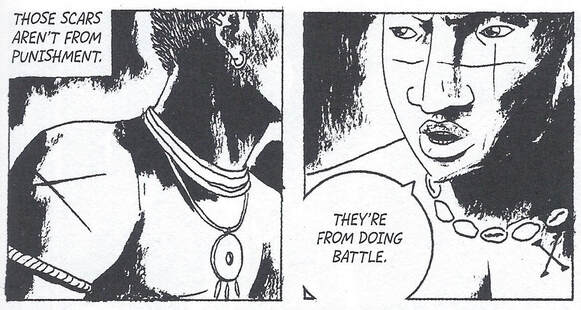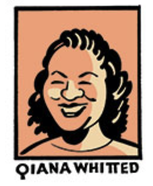|
I was invited to contribute an essay for the summer 2020 cycle of the "Black One Shot" series for ASAP/Journal online. My post reflects on the different visual representations and shifting meanings of bodily scars in Marcelo D'Salete's incredible graphic novel, Angola Janga: Kingdom of Runaway Slaves. Check it out and all the other great posts in the series here: http://asapjournal.com/b-o-s-9-3-angola-janga-kingdom-of-runaway-slaves-qiana-whitted/
My 2019 book, EC Comics: Race, Shock, and Social Protest has been nominated for a Will Eisner Comic Industry Award for Best Scholarly/Academic Work! Also nominated for Best Comics-Related Periodical/Journalism is Inks: The Journal of the Comics Studies Society, where I serve as editor. If you are a comics scholar, educator, librarian or a professional in the comics industry, you are eligible to vote for the recipients at http://eisnervote.com/. There are a lot of great nominees this year and I'm very proud to be one of them.

I've been invited to give the academic keynote address at the Michigan State University Comics Forum, Feb. 23-25, 2019. Seth will be delivering the artist keynote and he designed this terrific poster (which even includes an illustration of me!). I'm really looking forward to it.
I took part in several interviews during February 2018 to discuss Marvel's Black Panther film, including a short feature on WIS-10 and a panel on Cynthia Hardy's radio show, On Point. I also appeared with one of my students on the WIS show "Awareness" for two segments (see video below).
 I've published a short article on Alyssa Cole's historical romance fiction for the online journal, Public Books. The piece focuses mostly on Cole's recent novel, An Extraordinary Union, which I really enjoyed. I had initially planned to discuss her work as part of these two collections: Daughters of a Nation: A Black Suffragette Historical Romance Anthology and The Brightest Day: A Juneteenth Historical Romance Anthology. I often teach the novels of Beverly Jenkins in my course on slavery, literature, and popular culture, so it was thrilling to come across two anthologies with such well-crafted, historically-informed stories within the romance genre. Daughters of a Nation is my favorite of the two and while I'm a big admirer of Cole's style, I was also impressed by Piper Huguley's story called "The Washerwoman's War" (featuring poet Francis Ellen Watkins Harper's daughter as the main character!) along with the contributions by Lena Hart and Kianna Alexander. If you are interested in fiction about black women's history - even if you've never picked up a romance novel - I would strongly encourage you to give Cole's books and these two anthologies a try. Check out my article here! I'm honored to have been interviewed by Osvaldo Oyola at the comics and culture blog, The Middle Spaces, for his second installment of "The (re)Collection Agency." The feature is described as "informal talks with comics scholars about their comics reading and collecting practices and how that intersects with their work." Osvaldo and I had a terrific conversation about my interest in comics about the South and my historical research on race and early 1950s comic books. Check it out!
Originally posted at The Hooded Utilitarian. Public outrage over the killing of 18-year-old Mike Brown in Ferguson, Missouri continues to amass its own tragic iconography. Handprints transform the so-called universal sign of surrender into a stronghold of dissent: “Hands up, Don’t shoot.” Hashtag memorials shape the interconnectivity of social media into a pictorial chorus of text: #BlackLivesMatter #JusticeforMikeBrown #ShutItDown. I think about my own son at two years old and already curling his brown fingers into Spider-Man web shooters, and vainly I hope that the right counter-visual will fix what’s wrong, or at least begin to impair what Matthew Pratt Guterl, refers to as “the familiar grammar of racial sight, through which a wallet becomes a gun or a Harvard professor becomes a burglar.” I also had the chance to consider how the call for racial justice registers through image when I toured the exhibit on “The Long March: Civil Rights in Cartoons and Comics” at OSU’s Billy Ireland Cartoon Library & Museum last month. Among the stately commemoration of landmark firsts – including incredible pages of original art from Pogo, Wee Pals, and Green Lantern/Green Arrow – the corner of the room displaying the editorial cartoons seemed louder and more demanding in their effort to picture the raucous discord of the moment. We can learn a great deal from the way Pittsburgh Courier cartoonist Sam Milai uses the Junior Astronaut Helmet as a visual metonym for the aspirations of a middle-class African American family (below), only months after Neil Armstrong walked on the moon: In another image, Bill Crawford speaks to fears over militant Black Nationalism in a cartoon that invokes the Ku Klu Klan to set the boundaries of acceptable (and respectable) protest in 1968:
Originally posted as part of the Groensteen and Page Layout Roundtable at Hooded Utilitarian.  The previous contributions to our roundtable have raised important questions about Thierry Groensteen’s approach to page layout in Comics and Narration. While a rich array of images in Adrielle Mitchell’s post encouraged us to consider how frame irregularities produce meaning, Roy Cook set the stage for an important conversation about the values comics readers attribute to different panel arrangements. Roy’s post really got me thinking about the way Groensteen privileges the layout pattern of the “waffle-iron” by identifying stability, simplicity, and transparency as fundamental attributes of the orthogonal shapes. Groensteen further conceptualizes the grid in the narrative rhythm of comics as the “basic beat” against which the visual and verbal elements of comics can improvise. From this perspective, it’s not difficult to see how one might characterize the grid as “regular” or “neutral” or “invisible,” but I remain troubled by the relative nature of these terms, who defines them and in what context. To complicate the issue, my first instinct was to seek out comics that delight in the wildly experimental layouts that Groensteen might find “more sophisticated (or more hysterical),” but Adrielle’s post provides several excellent examples already. So I thought I would ask instead about comics that use the grid, but in unexpected ways: how do comics adapt the basic panel layout in order to stray from what Roy described as Groensteen’s “waffle-iron way of truth”? When is a grid not just a grid? I wonder, for example, how a comic like “The Harvey Pekar Name Story” fits into our understanding of frame regularity and rhythm. Though we may be inclined to make assumptions about its uniformity at first glance, R. Crumb has not simply drawn 48 identical copies of the same man in the squares of this four-page comic about the different Harvey Pekars listed in the phonebook. |
AboutAn archive of my online writing on comics, literature, and culture. (Illustration above by Seth!) Categories
All
Archives
July 2020
|









 RSS Feed
RSS Feed